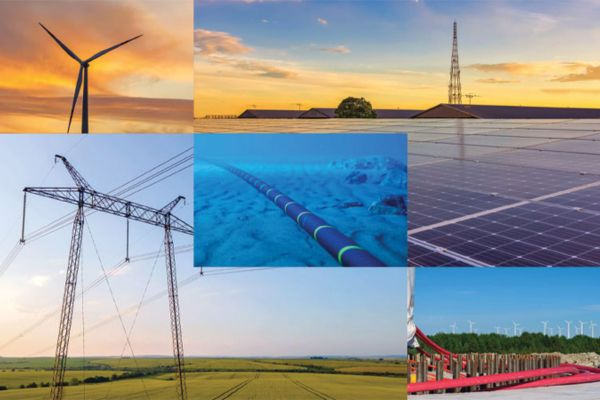India’s journey toward becoming a global leader in renewable energy has been underpinned by a robust and evolving electricity transmission infrastructure. Before the widespread adoption of renewables, the country’s transmission network played a pivotal role in connecting diverse regions, balancing supply and demand, and laying the groundwork for future energy transitions.
Evolution of India’s Transmission Network
India’s transmission infrastructure has witnessed significant growth over the decades. In March 2024, the country boasted approximately 481,326 circuit kilometers (ckm) of transmission lines and a transformation capacity of 12,25,260 MVA. This expansive network has been instrumental in facilitating the transfer of electricity across vast distances, ensuring that power generated in one region can be utilized in another.
The integration of regional grids culminated in the formation of the National Grid, enabling synchronized operations across the country. This unification has enhanced grid stability and efficiency, allowing for better management of electricity flows and reducing regional disparities in power availability.
Challenges in the Pre-Renewables Era
Despite the impressive expansion, India’s transmission system faced several challenges before the renewable energy surge:
Infrastructure Gaps: Rapid urbanization and industrial growth outpaced the development of transmission infrastructure in some areas, leading to congestion and reliability issues. System planning reports from the Central Electricity Authority have repeatedly emphasized the need for consistent upgrades to match demand growth.
Peak Demand Management: Managing peak load demands, especially during extreme weather conditions, posed significant challenges. For instance, in Last year in May, India experienced record-high temperatures, leading to unprecedented electricity demand. The grid managed a peak load of 250 million kilowatts on May 30, 2024, showcasing both the strain on the system and its resilience.
Transmission’s Role in Rural Electrification
Transmission infrastructure has been crucial in extending electricity access to rural and remote areas. Government initiatives like the Deendayal Upadhyaya Gram Jyoti Yojana (DDUGJY) have aimed to strengthen sub-transmission and distribution networks, facilitating rural electrification. By enhancing the transmission network, these programs have enabled the delivery of reliable power to previously underserved regions, contributing to socio-economic development.
The success of village electrification under DDUGJY, where nearly all inhabited villages were electrified by 2019, relied heavily on the reach and reliability of the transmission system. Without this backbone, local distribution would have remained ineffective despite infrastructure investments.
Private Sector’s Growing Contribution to Transmission
Over the past decade, the private sector has played an increasingly vital role in India’s transmission expansion. While public-sector utilities initially led the development of high-voltage networks, private participation gained strong momentum through tariff-based competitive bidding models. According to estimates from the Central Electricity Authority published in late 2023, the private sector was responsible for over 30% of the total transmission capacity added in the preceding five years (Power Line Magazine). This growing involvement has accelerated project delivery timelines, introduced modern technologies, and helped ease pressure on public infrastructure agencies, especially as India ramps up renewable energy integration and demand for inter-regional power transfer capacity continues to rise.
Preparing for Renewable Integration
As India sets ambitious renewable energy targets, the transmission network’s role becomes even more critical. The Central Electricity Authority (CEA) projects that to accommodate the anticipated growth in renewable energy, the country will need to add approximately 76,787 ckm of transmission lines and 497,855 MVA of transformation capacity by 2031–32.
Furthermore, the International Energy Agency (IEA) emphasizes the importance of modernizing grid infrastructure to handle the variability and decentralization associated with renewable energy sources. Investments in smart grid technologies, real-time monitoring, flexible transmission, and battery storage are essential to ensure grid stability and efficiency in the face of increasing renewable penetration.
Complementing this, According to Reuters it was estimated in mid-2024 that India would need to invest up to $385 billion to meet its clean energy goals by 2030, with about $150–$170 billion needed specifically for transmission and distribution upgrades over the next 6–7 years.
Conclusion
India’s transmission network has been the backbone of its electricity sector, enabling the distribution of power across diverse regions and supporting economic growth.
India’s transmission network has long served as the backbone of its power sector, enabling energy access across regions and supporting economic growth. Today, as the country enters a new energy chapter, it’s not just the infrastructure that’s evolving so is the mindset. With a more skilled, educated, and forward-thinking generation stepping into leadership and engineering roles, the pace of progress is accelerating. The youth of today bring a renewed sense of innovation and independence, making it possible to achieve ambitious sustainability and energy goals faster and more effectively than ever before.

Shalin Sheth, Founder & Managing Director at Advait Energy Transitions Limited














